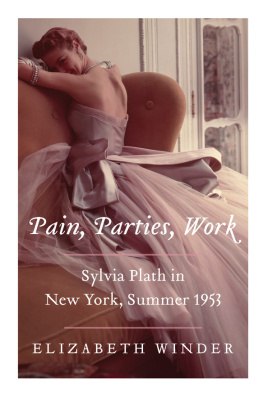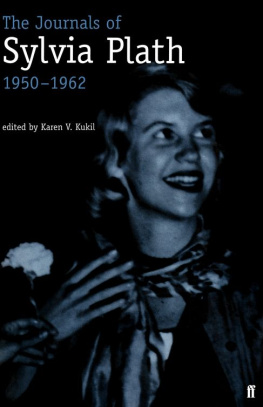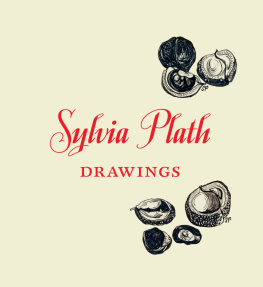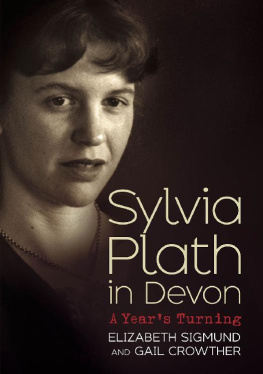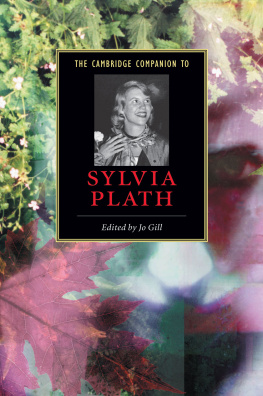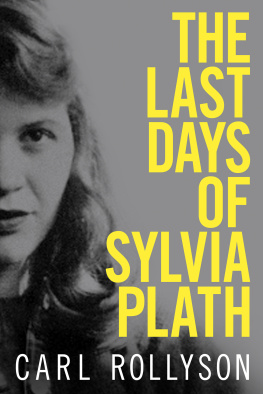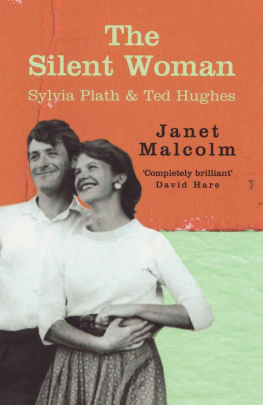for Medora
You are twenty.... The strange tableau in the closet behind the bathroom: the feast, the beast, the jelly bean.
SYLVIA PLATH
(November 14, 1952, The Unabridged Journals of Sylvia Plath, 19501962)
Marilyn Monroe appeared to me last night in a dream as a kind of fairy godmother. I spoke, almost in tears, of how much she and Arthur Miller meant to us, although they could, of course, not know us at all. She gave me an expert manicure. I had not washed my hair, and asked her about hairdressers, saying no matter where I went; they always imposed a horrid cut on me. She invited me to visit her during the Christmas holidays, promising a new, flowering life.
SYLVIA PLATH
(October 4, 1959, The Unabridged Journals)
Contents
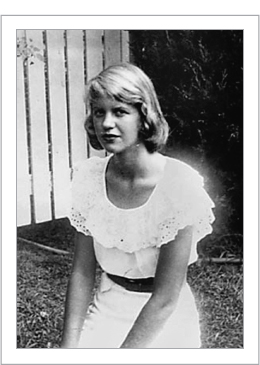
Sylvia Plath was fully immersed in the material culture of her time. She took real pleasure in clothes, makeup, magazines, and fooda fact that runs counter to the crude reductions of Plath as a tortured artist. Sylvia was highly socialshe volunteered, joined clubs, attended lectures, parties, and dances. At twenty, she was more likely to view herself within the context of her peer group than as an isolated individual.
The bras, lipsticks, and kilts included in the book are vital (Plaths favorite word) to understanding Sylvia as both participant and product of midcentury America.
In New York, Sylvia lived and worked with nineteen other girls at the Barbizon Hotel for Women. As these women shared their memories of June 1953, I realized that the difficulties Sylvia endured were not unique, but part of a larger crisisbeing an ambitious, curious girl in the 1950s.
Sylvia Plath committed suicide with cooking gas. She was thirty, and she will always be thirty, wearing her long hair braided in a brown crown round her head. Her skin had gone pale from insomnia and English weatherit was the nuclear winter of 1963Londons coldest since the days of King James when the Thames froze over.
But this is a different story, and a different Sylvia. Not that frozen February tundra of 1963, but ten years earlier, during a venomously tropical summer of record-breaking heat. Before the wet towels and baby buntings. Before the children and the books. Before London and Devon and the dour brown braid. Before the mugs of milk, the bread and the butter, the duct tape. Before the carbon monoxide and the oven, with its strange domestic witchery. Before she became an icon, before she was Lady Lazarus, she was Sylviaa New England college girl with an internship in Manhattan.
The stark facts of Sylvia Plaths suicide have led to decades of reductionist writing about her person and her writing. Pain Parties Work is an attempt to undo the clich of Plath as the demon-plagued artist. This is a story of an electrically alive young woman on the brink of her adult life. An artist equally attuned to the light as the shadows, with a limitless hunger for experience and knowledge, completely unafraid of lifes more frightening opportunities. All New Yorks gory beauty shooting through her in a white-hot current. Someone vulnerable and playful, who loved to shop as much as she loved to read. This Sylvia has blond hair, a deep tan, one suitcase, several boyfriends, two black sheaths, and a ticket to New York City. Starting on June 1, 1953, she will join nineteen other college girls to work on Madison Avenue as a guest editor for a fashion magazine called Mademoiselle.
Spring 1953. Aldous Huxley was experimenting with mescaline in West Hollywood. There was a new vaccine for polio, and someone had finally reached the summit of Mount Everest. Joseph Stalin died, and Elvis Presley graduated from high school. Queen Elizabeth II was preparing for her coronation at Westminster Abbey. John Kennedy and Jacqueline Bouvier decided to go public and announce their engagement, and William S. Burroughs was in Tangier writing Naked Lunch.
Sylvia Plath was packing slips, sheaths, skirts, and nylons at her home in Wellesley, Massachusetts. She was going to New York.
GUEST EDITORS
Ruth Abramson
Margaret Affleck
Nedra Anderwert
Candy Bolster
Betty Jo Boyle
Ann Burnside
Malinda Edgington
Laurie Glazer
Gloria Kirshner
Dinny Lain(Diane Johnson)
Carol LeVarn
Grace MacLeod
Madelyn Mathers
Eileen McLaughlin
Neva Nelson
Sylvia Plath
Del Schmidt
Anne Shawber
Laurie Totten
Janet Wagner
MADEMOISELLE EDITORS
Betsy Talbot Blackwell (Editor in Chief)
Cyrilly Abels (Managing Editor)
Marybeth Little (College Board Editor)
Margarita Smith (Fiction Editor)
Gigi Marion
Kay Silver
Geri Trotta
Polly Weaver
I dreamed of New York, I am going there.
SYLVIA PLATH
(May 15, 1953, The Unabridged Journals)
H er room was the size of a decent closetbeige walls trimmed in maroon paint. A dark green carpet, ferny bedspread with rose-patterned ruffles like Snow Whites muted forest. There was green upholstery on the low parlor chair. A desk for typing wedged neatly at the beds foot. Above the bed there was a speaker box that piped in classical music if you turned a knob. A white enameled bowl bloomed out of one walluseful for washing out white cotton gloves. (Within days there would be little damp gloves hanging in each room like tiny white flags.)
The Barbizon stood on the corner of Lexington Avenue and 63rd Streettwenty-three floors of warm pink brick with curly flourishes. Sylvias room faced east. She loved her viewthe Third Avenue El, the new United Nations buildingshe could even catch glimpses of the East River. She kept her windows open the entire month.
The boxlike room meant freedom.
Since the 1940s, the Barbizon had been a hothouse of pretty, brainy American ingenues. (And Sylvia would play up this tropical exoticism by rechristening the hotel the Amazon in The Bell Jar.) Aspiring actresses, writers, editors, and models thrived and withered within the hotels pink walls. The atmosphere in the seven hundred tiny rooms was humid and claustrophobic. Barbizon girls steamed with ambition and anxiety, eager to join the ranks of the hotels most famous resident, Grace Kelly.
I remember my arrival at the Barbizon, registering at the desk and meeting some of the girls who were arriving at the same time. Everyone was friendly but low-key, as if we were keeping our enthusiasm to ourselves. Perhaps we felt too unsure of exactly what to expect and therefore refrained from any impulse to giggle or gush. Most exhibited polite and possibly feigned self-confidence.
L AURIE T OTTEN
The Barbizon promoted itself as a sorority of ambitious, discriminating young women. Model agencies and parents alike approved. With mandatory teas, curfews, and chaperones, the Barbizon was like an upscale nunnery. Demerits were given to girls who came in past curfew or looking rough.
Yet despite this, the hotel held women like Sylvia Plath in a glossy thrall. And the allure had little to do with bridge games and prearranged dates to the Stork Club.
Sylvia Plath and the Barbizon girls wore girdles, conical bras, kitten and Cuban heels. Whether playing badminton or clacking away at a typewriter, they worked at cultivating a veneer of knowing sophisticationthey wanted to own the ladylike details of their dresses and clutches. The goal was to feel and look as turned out and spotless as a white kid glove. It was 1953four years before Audrey Hepburn proved you could be sexy and bookish at once in Funny Face.

